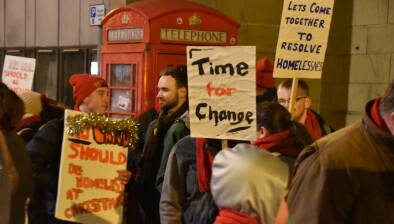New report calls for ‘supported lodgings’ model for young homeless people
 A ‘supported lodgings’ model must be introduced in Scotland to urgently address youth homelessness and reduce reliance on hostel and B&B accommodation, a new report has found.
A ‘supported lodgings’ model must be introduced in Scotland to urgently address youth homelessness and reduce reliance on hostel and B&B accommodation, a new report has found.
While levels of youth homelessness have been falling in recent years in Scotland, 16-24 year olds remain heavily over-represented in the homeless population. Official statistics show that during 2016/17, 1,755 temporary accommodation placements for young people were into hostels and 670 into B&Bs, despite these kinds of accommodations often being unsuitable for their needs.
Supported lodgings provide young people with a room of their own in the home of a vetted and trained private household, with support provided to both the host household and young person from a specialist organisation.
A report for Shelter Scotland authored by Heriot-Watt University said the model allows young people to live in a secure and safe environment in which they can build up their independent living and life skills, and progress towards a range of positive outcomes including education and employment.
Supported lodgings is already an established model and used to accommodate and support young people experiencing homelessness in some areas of the UK, the USA and Canada. In Scotland, it is an established model for care leavers, but is not currently used as a widespread response to youth homelessness.
Dr Beth Watts from the Institute for Social Policy, Housing, Equalities Research (ISPHERE), at Heriot-Watt University led the research.
She said: “The findings provide strong support for the development and growth of Supported Lodgings schemes in Scotland, targeting young people who are at risk of or experiencing homelessness.
“It’s clear there is an urgent need. Existing accommodation options for young people are inadequate. Despite improvements in recent years, too many young people are still living in B&B and hostel accommodation at some point in their ‘homelessness journey’, an experience they can find isolating, intimidating and even harmful. For those that move into independent housing before they want to or with insufficient support, there is a heightened risk that the tenancy can break down.
“This is not a radical or risky innovation but a tried and tested model demonstrating success elsewhere in the UK and abroad. While more floating support in independent accommodation will be the solution for some homeless young people, supported lodgings provide an additional and unique option that young people and sector experts in Scotland agree has a potentially valuable role to play.”
Utilising this research, Shelter Scotland has developed a model for how these services could be delivered in Scotland to support organisations to develop their own services to provide young people with a home.
George Drennan-Lang, head of business development at Shelter Scotland, added: “We hear every day from young people facing homelessness who desperately need help and for some, not all the options available to them are appropriate to their personal circumstances. Not every young person who is homeless or at risk of homelessness wants to or is ready to move into their own tenancy straight away. We think a Supported Lodgings service, with specially trained hosts, would provide some young people with the secure home environment they need to help move forward in life.”
The report highlights the necessary ingredients for the successful introduction of supported lodgings in Scotland as well as evidencing of the strong sector support for the model among the youth homelessness providers, local authority commissioners and other homelessness experts.
The model further builds on the community hosting recommendations made by the Homelessness and Rough Sleeping Action Group that were accepted in principle by the Scottish Government and housing minister Kevin Stewart in May.
The report research was funded through an award from the European Structural Funds Social Innovation Fund.








